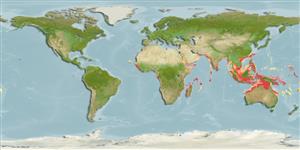Ikan bertulang rawan (sharks and rays) >
Carcharhiniformes (Ground sharks) >
Carcharhinidae (Requiem sharks)
Etymology: Carcharhinus: karcharos (Gr.), sharp or jagged; rhinus, an ancient name for sharks, from rhine (Gr.), rasp, both words alluding to a shark's jagged, rasp-like skin. (See ETYFish); amboinensis: -ensis, Latin suffix denoting place: Ambon Island, Moluccas Islands, Indonesia, type locality. (See ETYFish).
More on authors: Müller & Henle.
Environment: milieu / climate zone / depth range / distribution range
Ekologi
laut; payau berasosiasi dengan karang; kisaran kedalaman 0 - 150 m (Ref. 9997). Tropical; 26°N - 26°S
Eastern Atlantic: Nigeria. Indo-West Pacific: Persian Gulf (Ref. 68964), Gulf of Aden, South Africa, Madagascar, Pakistan, Sri Lanka, Indonesia, Papua New Guinea (Ref. 6871), and Australia. Also reported from the Mediterranean (Ref. 83386). Often confused with sympatric Carcharhinus leucas and Glyphis gangeticus but the three are distinguishable.
Length at first maturity / Size / Weight / umur
Maturity: Lm 212.0, range 198 - 223 cm
Max length : 280 cm TL jantan/; (Ref. 2334)
Duri punggung (Keseluruhan (total)): 0; duri punggung lunak (Keseluruhan (total)): 0; Duri dubur 0; Sirip dubur lunak: 0. A massive shark with a thick-set head, a short, broad and blunt snout, small eyes and large, triangular, saw-edged upper teeth; 1st dorsal fin high and erect, at leas 3.2 times height of 2nd dorsal fin; no interdorsal ridge (Ref. 5578). Grayish in color, white below; fins with dusky tips (Ref. 5578).
An inshore species of the continental and insular shelves, commonly inhabiting shallow waters close inshore, near the surf line and along beaches (Ref. 244). It also occasionally enters brackish water (Ref. 127434), and may be found in shallow bays and estuaries, as well as off the open coast but not ascending rivers (Ref. 9997). Predominantly demersal but found throughout the water column (Ref. 6871). Feeds on pelagic and demersal bony fishes, sharks and rays, squid, shrimps, cuttlefish, octopi, lobsters, gastropods and mammalian carrion (Ref. 5578, 9997). Viviparous (Ref. 50449). Potentially dangerous but not recorded in shark attacks to date (Ref. 9997). Utilized fresh and dried-salted for human consumption (Ref. 9997).
Viviparous, placental (Ref. 50449), with 3 to 13 in a litter (Ref. 9997). Size at birth about 43 to 53 cm TL (Ref. 9997); 60-70 cm TL (Ref.58048). Distinct pairing with embrace (Ref. 205).
Compagno, L.J.V., 1984. FAO Species Catalogue. Vol. 4. Sharks of the world. An annotated and illustrated catalogue of shark species known to date. Part 2 - Carcharhiniformes. FAO Fish. Synop. 125(4/2):251-655. Rome: FAO. (Ref. 244)
Status IUCN Red List (Ref. 130435)
ancaman kepada manusia
Traumatogenic
penggunaan manusia
Perikanan: nilai komersial kecil; Ikan buruan: ya
informasi lanjut
AcuanBudidaya airprofil budidaya airStrainGenetikaElectrophoresesDiturunkanPenyakit-penyakitPengolahanNutrientsMass conversion
mitraGambarStamps, Coins Misc.Suara-suaraCiguateraKecepatanTipe renangArea insangOtolithsOtakPenglihatan / visi
Alat, peralatan
laporan khas
muat turun XML
Sumber internet
Estimates based on models
Preferred temperature (Ref.
123201): 24.5 - 28.9, mean 27.7 °C (based on 1396 cells).
Phylogenetic diversity index (Ref.
82804): PD
50 = 0.5000 [Uniqueness, from 0.5 = low to 2.0 = high].
Bayesian length-weight: a=0.00479 (0.00221 - 0.01036), b=3.09 (2.92 - 3.26), in cm total length, based on LWR estimates for this Genus-body shape (Ref.
93245).
Trophic level (Ref.
69278): 4.3 ±0.5 se; based on diet studies.
Daya lenting (Ref.
120179): sangat rendah, Waktu penggandaan populasi minimum lebih dari 14 tahun (Fec=3).
Fishing Vulnerability (Ref.
59153): Very high vulnerability (90 of 100).
Nutrients (Ref.
124155): Calcium = 5.19 [1.04, 27.63] mg/100g; Iron = 0.349 [0.083, 1.002] mg/100g; Protein = 22.4 [19.6, 24.7] %; Omega3 = 0.111 [0.044, 0.268] g/100g; Selenium = 36.6 [10.3, 98.5] μg/100g; VitaminA = 41.8 [13.7, 134.3] μg/100g; Zinc = 0.591 [0.280, 1.153] mg/100g (wet weight);
